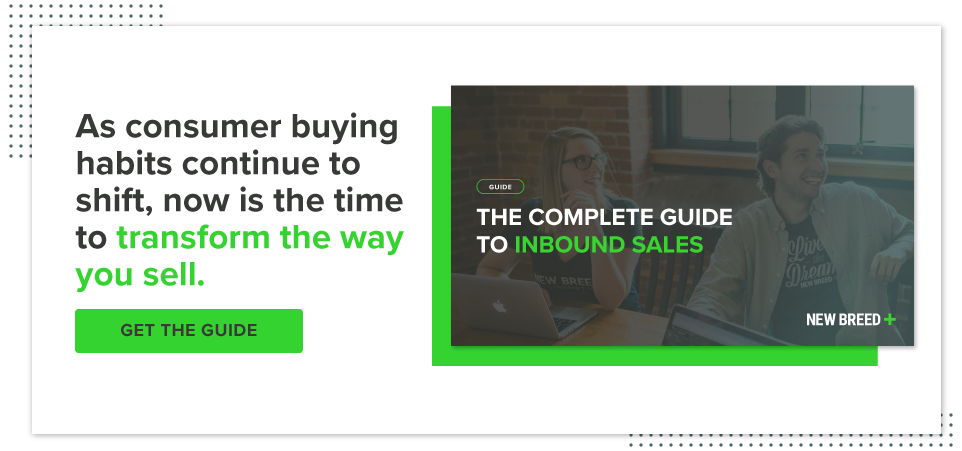How to Treat Inbound Leads Differently from Outbound Leads

How a lead entered into the sales pipeline will impact how a sales rep should conduct outreach in order to be most effective. Outbound and inbound leads are different, and reps that ignore those differences will struggle to be successful.
“You need to have different messaging and a different approach depending on where your leads are coming from and what they engage with,” Inside Sales Manager Beth Abbott says.
Inbound vs. Outbound Leads
In order to get inbound leads into the sales pipeline, you first attract them to your website and then engage and nurture them with helpful educational content. They’re guided by marketing through the buyer’s journey, and once they’ve reached a point that they’re ready to talk to sales, marketing hands them off.
Outbound leads, on the other hand, did not indicate an interest in your product or service prior to a sales rep reaching out. Instead, they’re found through prospecting.
“With inbound leads, there’s a very clear line of understanding from a specific person at a prospective company of who we are, whether that’s just that they’ve been to our blog before or they’ve downloaded our content,” Beth says. “There’s some familiarity, and a lot of your focus for outreach can be around that commonality.”
Reps can use an inbound lead’s digital body language to understand their interests and challenges. There’s a record of the content they’ve consumed and the forms they’ve submitted. This knowledge also makes it easier to prioritize inbound leads than outbound leads, because you can use behavior to know when it’s the best time to reach out.
“When we do outreach, it’s a huge leg up to be able to lean on what content prospects are actually consuming,” Beth says.
Outbound leads don’t have a history with your company, so reps need to find an alternative way to form a connection.
“What you have to make sure you’re still doing with outbound outreach is that you’re still finding a commonality that could exist, even though you don’t have that lead intelligence from marketing,” Beth says.
The core ways you can establish a connection are:
- Trigger events: What’s happening within their job or their company that might prompt outreach? Did something like a job change or a funding round occur?
- Connect the dots: Do you have shared networks or backgrounds that can be leveraged?
- Observations about their company: Do you have any observations about their website or the work their company has been doing. This one is the hardest to do because it can easily come off as too aggressive.
Because of the differing levels of familiarity with your company, the amount of time it takes for reps to go from initial outreach to booking a meeting also varies for inbound and outbound leads, and reps need to set their expectations accordingly.
“Unless you’re hitting someone with outbound at the exact right time, your goal should not be booking a meeting. It should be getting them familiar with who you are as a company,” Beth says.
Beth recommends starting by sending them links to your website and relevant content you’ve created, almost as if you’re trying to turn them into an inbound lead.
“It’s all about timing with outbound, so what you want to make sure you do as a rep, is if it’s not the right time — which most of the time it won’t be — have a plan for a longer-term nurture strategy that adds value rather than pestering them for a meeting at a time that doesn’t make sense,” Beth says.
With inbound leads, that familiarity has already been established, so you can request a meeting sooner in your communications.
“Your goal and your objective can be a little more direct [with inbound leads],” Beth says.
Ensure you’re still being helpful above all else, but if an inbound lead’s actions indicate they’re ready to meet, you can definitely reach out with a message along the lines of “Hey, I noticed you’ve been looking at these resources on my website. Do you want to hop on a call to talk about them?”
Transitioning from an Outbound to an Inbound Approach
Relying solely on outbound sales methods is not sustainable for a company. It takes a greater investment in the form of contact lists and prospecting tools, requires more of a reps’ time and doesn’t drive long-term results as well as inbound.
So, it’s essential that companies who haven’t already started adding inbound into their marketing and sales strategy do so. The first step to doing so is aligning your marketing and sales teams.
For inbound, understanding digital body language is super important, and that requires not just training reps on how to analyze data, but also for your tech stack to be set up to collect that data accurately and make it accessible for sales reps.
Marketers are typically the ones collecting data on inbound leads, so they need to be passing it on to sales reps, and sales reps need to be comfortable talking to marketers if they’re not getting the information they need.
Additionally, marketing should train the sales team on what the engagement data they’re passing on means and how it can be leveraged to help with sales outreach.
Inbound marketing content is created to address specific pain points prospects have, and sales reps should be able to identify what pain points correspond with different content offers.
“You need to be able to associate what the engagement means with what challenges the prospect could be having and how to turn that into usable sales messaging,” Beth says.
In addition to analyzing the behavior data you receive from marketing, you also need to research more about the prospect and their company. Just because you receive a lot of information from marketers doesn’t mean you know everything you need to know. You’ll still need to do a little research to understand the prospect and the company they work at so you can have an informed conversation.
“The same way that marketing wants to tailor campaigns depending on personas and industry, a sales reps’ outreach for inbound should also be tailored very granularly to those people,” Beth says.
For reps used to taking a very cold, outbound approach, this means that they’ll need to switch up their communications from large batches of cookie-cutter automated emails to a smaller number of highly-personalized communications.
Transitioning from outbound to inbound also requires a shift in approach.
“The whole idea of inbound sales and inside sales is that you’re giving value before you’re getting it — on every single touchpoint,” Beth says. “Just because you have all this information on someone and you know they’re interested still doesn’t mean you go in and make it about you. You go in, make it about them and see if there’s other stuff that’s going to add value and be helpful for them before you ask for something in return.”
Whether you’re asking for their time, a meeting or even just the answer to a quick question, always provide something first.
How to Add Outbound to Your Inbound Approach
Outbound can be done in an inbound way though, and complement your inbound efforts.
“If you ignore the outbound side of things, then you’re not building up relationships that are going to come into play a couple months down the road,” Beth says.
When sourced strategically, outbound leads also have the benefit of always being a good fit.
“With inbound, you know their interest, but you don’t always have all the understanding of fit criteria going into that outreach,” Beth says.
So with outbound leads, you can focus on stoking interest, knowing that once you do and the time is right you’ll convert a high-fit customer.
Beth recommends taking an account-based marketing-like approach to how you source and categorize outbound leads: only spend time working ones that are definite fits for your customers and spend the majority of your time nurturing the leads that match your company’s ideal customers.
You can determine what type of companies are the best fit by analyzing your existing customer base and seeing where you have the most excess.
Outbound leads do require more time and effort, but they can pay off at a higher rate due to how strategically they’re selected.
The Takeaway
Inbound methods are more effective in the long-term, but outbound tactics can be a great supplement to round out your efforts.
“It’s going to differ for every company how much time you’ll spend on outbound versus inbound,” Beth says. “What you need to do as a company is determine what percentage of revenue is coming from inbound-sourced deals and then what percentage needs to be supplemented if you’re not making up the difference.”
Ideally, your sales team should be pursuing a combination of both inbound and outbound leads.
Quinn Kanner
Quinn is a writer and copyeditor whose work ranges from journalism to travel writing to inbound marketing content.





